By: Danyun Xiong, Phoo Pwint
The year 2020 is unlike any other in the course of human history. The outbreak and widespread of COVID-19 have wreaked havoc not only on people’s health but more importantly, on nearly every aspect of socio-economics in human society.
According to the International Monetary Fund (IMF), the global economy is estimated to shrink 4.9 percent in 2020, a decline that inflicted considerable hardship on many people. International Labor Organization (ILO) suggests that this recession caused an unprecedented global employment loss of 114 million jobs, and women suffered higher employment losses (5.0 percent) in 2020.
Unemployment is only the tip of the iceberg that emerges in this crisis. Beneath the surface, unpaid work, wage gap, mental health, domestic violence, etc. intertwine with one another, leaving more suffering to women.
In this article, we try to focus on how women’s employment rate, their unpaid work hours, and income change before and after the pandemic.
Female labor force participation
With economic development, technology innovation, and education progress, women’s labor force participation has been increasing in the last century. ILO research shows that in 2019, women’s global labor force participation rate stood at a mere 47%, compared to 74% for men. Small as it may seem, it is huge progress. Throughout the world, women have fewer working opportunities in history. Taking the US as an example- in 1900, women were about 21.2% of all people in the labor force. Today, women make up about 47% of the U.S. labor force, a two-fold increase in the last century.
However, the pandemic has regressive effects. PwC’s annual Women in Work Index analysis demonstrates that progress for women in work could fall back to 2017 levels due to COVID-19 by the end of 2021. In the US, women lost 55.0% of the 9.6 million net jobs in this crisis. Working hours have decreased, too. CJRS shows that 65% of female employees aged 17 were furloughed, while male counterparts had a 62%. In light of this, we’ll take a look at the data of unemployment rates by age and sex in 2020.
Dataset 1: Numbers from U.S. Bureau of Labor Statistics, processed with Tableau
Unemployment Rate by Age (Female)

Unemployment Rate by Age (Male)
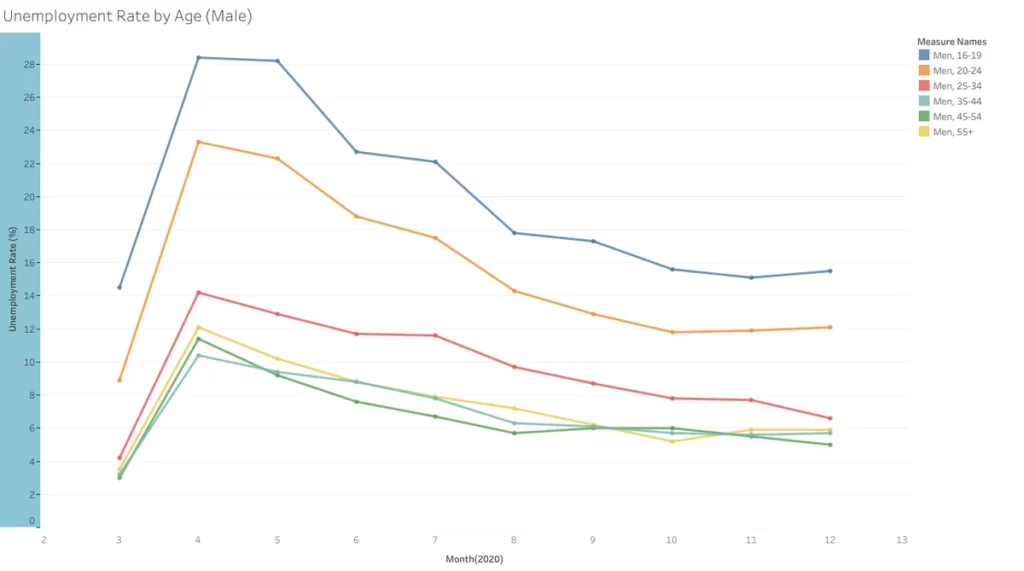
Unemployment Rate by Age (Total)
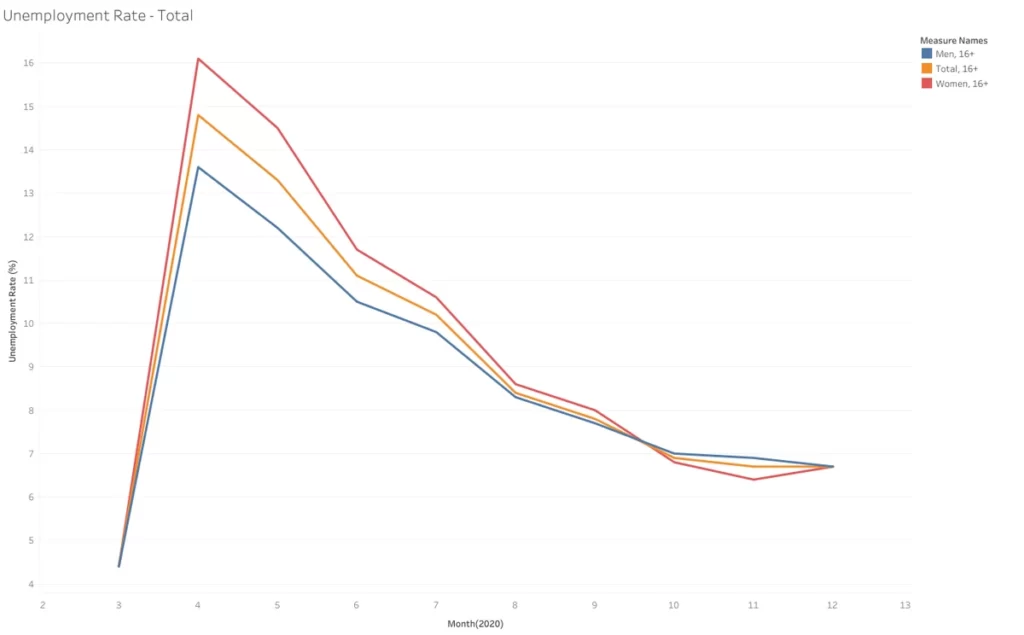
The above-mentioned numbers only account for part of the story on women’s work status. A question naturally arises– where are the rest of the women, don’t they have to work? The fact is that they do. Women often engage in various forms of work, but what they do is seldom called “work”.
Women and Care Work
On the flip side, women generally spend more time than men doing unpaid care work, such as cleaning, cooking, caring for children and the elderly at home. These unpaid works sound trivial but are essential to keeping a household running and living a good life. Globally, women take on75% of all unpaid care work—and the COVID-19 pandemic has only exacerbated this burden. OECD Development Center shows that across the world, women spend on average between three and six hours on unpaid caregiving responsibilities while men spend between half an hour and two hours. The informal works at home take up several hours a day that women don’t have enough time to work in offices or businesses which generate visible profit. Globally, if women earned a minimum wage for the unpaid work for their families, they would have made $10.9 trillion.
During the pandemic, the shutdown of public services and closures of schools have strengthened the pre-existing gender norms. Due to the lack of domestic workers, women, either employed or unemployed, increased their time at home and undertake a disproportionately great bulk of unpaid chores in the household. In light of this, we could have a glimpse of women’s working hours versus those of men’s.
Dataset 2: Data source from OECD Statistics, processed with Tableau
Comparison: Time Spent on Works (Total)
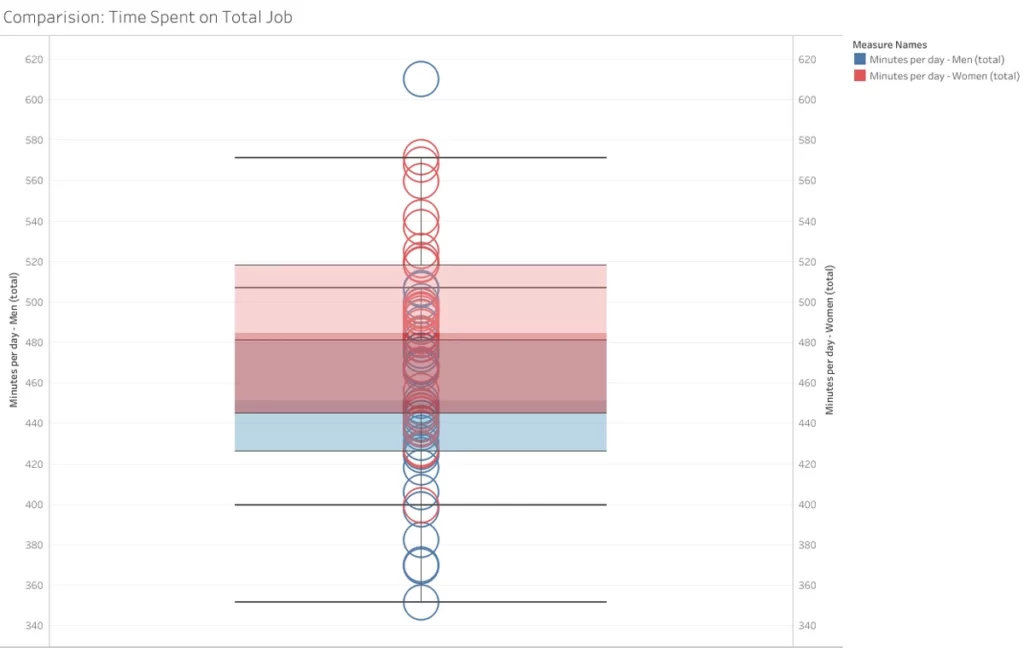
Comparison: Time Spent on UNPAID Works
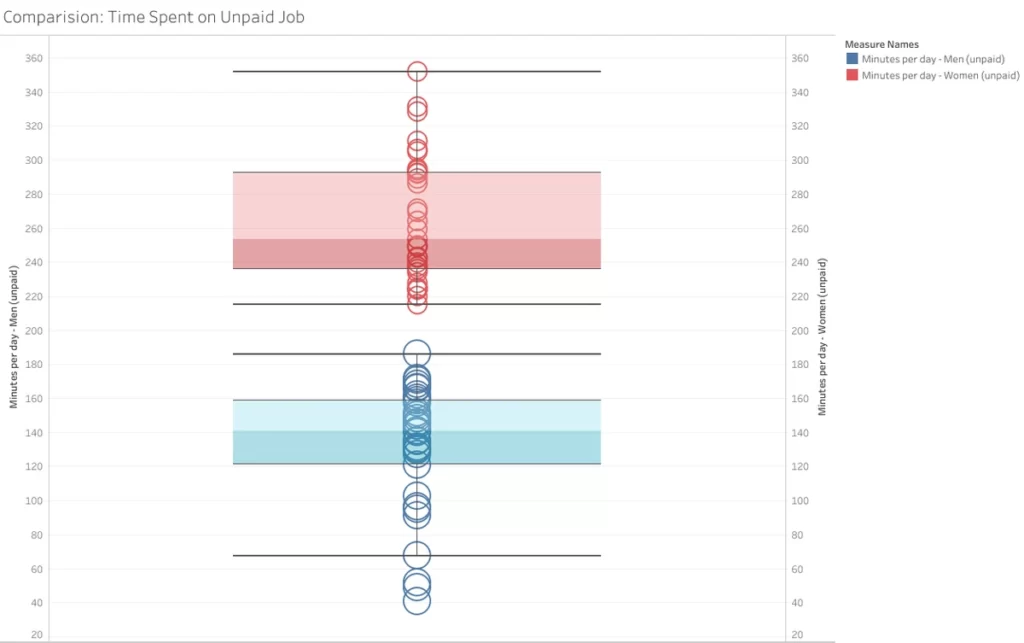
Comparison: Time Spent on PAID Works
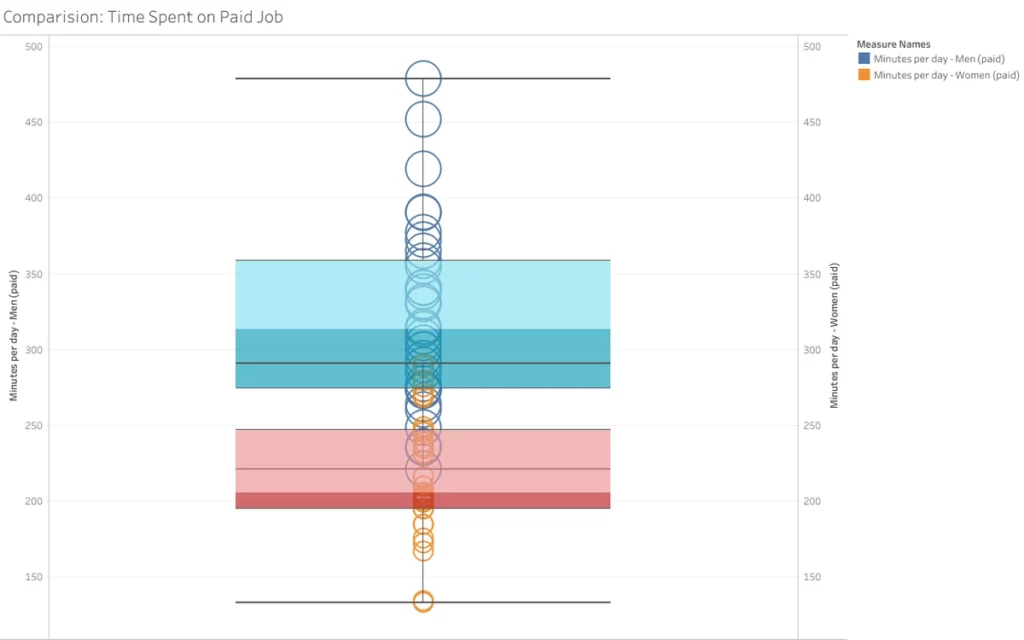
Gender income gap
Even women who are fortunate to realize their potential in the workplace, are not lucky enough to avoid gender disparity. Behind both formal and informal work, the gender pay gap is a long-standing issue faced in the world today. Compared to men, women tend to earn less. Around the world, women are estimated to earn 23% less than men. During the pandemic, factors such as lack of flexibility at work, anxiety over layoffs, family care, household chores, mental health, etc. are likely to have pushed women out of work. With the pressure of undertaking so many family responsibilities, women are unlikely to concentrate on work and perform at their best.
Another big issue is an ‘Unentitled Mindset’. This is the way that women are conditioned to feel less entitled than men in all areas of their lives. To expect less, and not to demand more leads to inequality in pay, domestic load, childcare, parental care, and unpaid work. This system can intentionally exploit and benefit from this entitlement gap, which widens when we factor in women from marginalized backgrounds and intersectionality.

PayScale shows that in the United States, women make only $0.82 for every dollar a man makes in 2021, which is one cent more than they made in 2020. It seems contrary to our common sense. This minor improvement is probably because lower-paid women leaving the workforce voluntarily out of caring for family members or involuntarily out of unemployment, knowing that across the world, 40% of all employed women are employed in the “hard-hit” sectors. Race is also a factor that influences the wage gap. Women of all races and ethnic groups earn less than white men. To learn more about the gender income gap, we could check the dataset below.
Dataset 3: Figures and Pictures from PayScale
The Racial Wage Gap
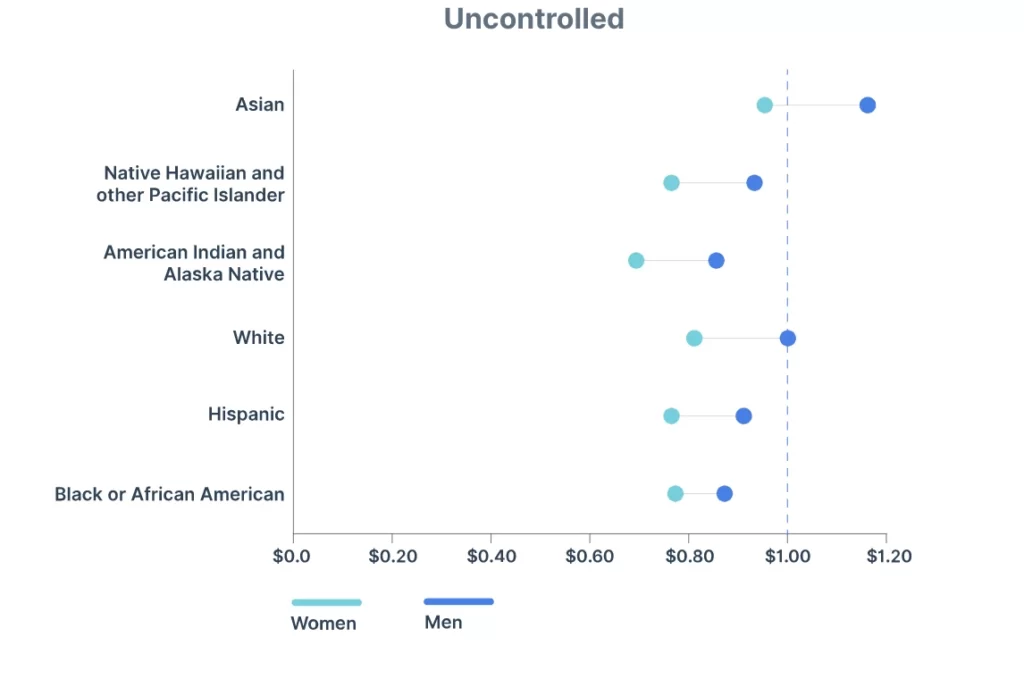
The uncontrolled pay gap widens among laid-off workers

Gender Pay Gap by country from OECD:

Break the vicious cycle
The gender pay gap will not evaporate on its own. It is the responsibility of companies, employees, and individuals to change societal beliefs and norms toward gendered pay.
To start, workplace attitudes and culture need to change. Companies should make efforts to ensure more women are considered eligible for senior roles, provide transparency around pay and promotions, and encourage men and not just women to use parental leave.
To close gender pay gaps and promote women’s participation in the workforce, we need meaningful commitment from government and businesses, as well as solutions that seek to tackle the root causes.
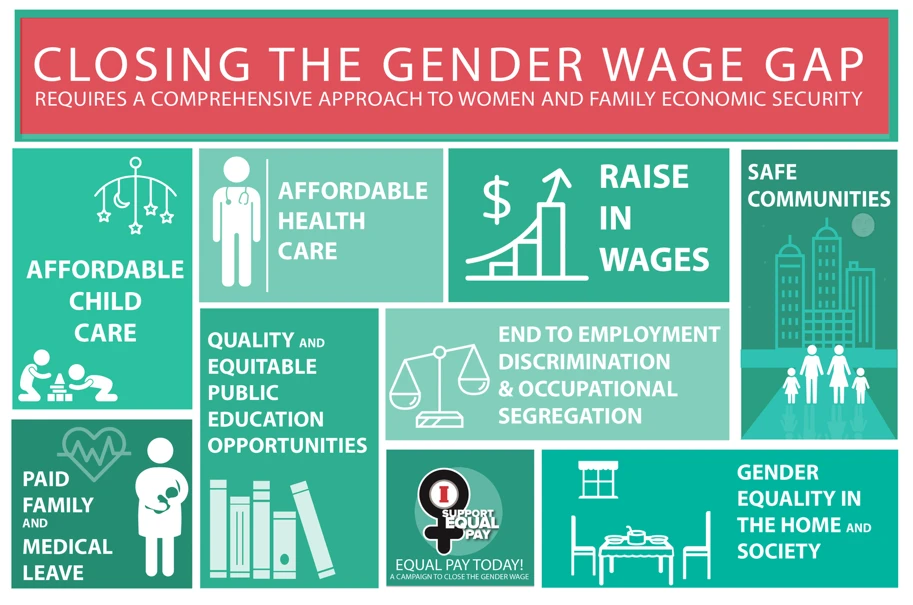
1. Ensure equal pay: Commit to and ensure transparency around equal pay for equal work.
Efforts to close pay gaps should include an annual pay audit and mechanisms to ensure company-wide transparency around negotiation, pay, reward processes, and salary ranges. Companies like Salesforce are leaders in the fight for equal pay.
2. Overcome bias in the system and embed gender and race-conscious hiring
Al-based hiring platforms are becoming increasingly popular as a way to diversify the candidate pool and combat bias in hiring. Despite the varied success of these tools, businesses should employ cautious optimism with tech-based hiring solutions as they can prevent gender and race-conscious hiring by enabling gender and race-blind hiring.
3. Support mothers and families: Update and establish new policies that are gender-neutral and family-friendly.
To support the growth and development of all employees, businesses should establish progressive, gender-neutral paid parental leave policies that extend beyond legal requirements. Paid parental leave, as well as flexible and remote working policies, are good for families and good for employee retention.
On the whole, women are suffering from a disproportionate share of the economic recession. Fewer employment opportunities for women and the amplified gender wage gap would curb the human capital and undermine women’s role in society. A vicious cycle is formed: when women spend more time on household work, it would make them put less time on work and thus having fewer opportunities in the workplace, while this only increases their time at home and doing more chores. Gender disparity is detrimental to our society. In the long run, it hinders the development of a more equal and resilient world.
Women’s increasing participation in the workforce has benefited the economy greatly: it has helped to increase the competitiveness of labor markets, makes cities more productive, and increased overall wages to some extent. Companies, organizations, and policymakers should make sure that women’s rights are represented and voices heard so that things would not go backwards.
As ILO Director-General puts it, “humanity can only be at its best when gender equality becomes a reality for all, everywhere.” COVID-19 reminds us that gender inequality needs to be addressed. Actions ought to take to close these gaps and to improve gender equality.


